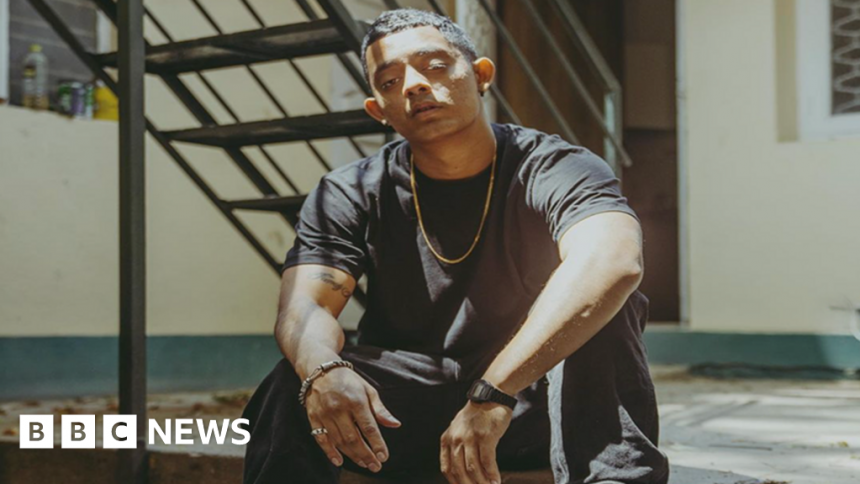The Indian rapper who overtook Kendrick Lamar on music charts
 Hanumankind/Instagram
Hanumankind/InstagramIn a short time, Indian rapper Hanumankind has rapidly risen as a standout in the country’s burgeoning hip-hop scene. His track Big Dawgs not only topped global charts but also briefly outpaced Kendrick Lamar’s diss track Not Like Us. The BBC explores the rapper’s meteoric rise to fame.
In the video for Big Dawgs, 31-year-old Sooraj Cherukat, also known as Hanumankind, exudes boundless energy.
Shot inside a maut ka kuan (well of death) – a jaw-dropping show where drivers perform gravity-defying stunts inside a giant wooden barrel-like structure – he stomps around the pit as a group of motorists zip past him.
The song, a collaboration with producer Kalmi Reddy and director Bijoy Shetty, has earned over 132 million streams on Spotify and 83 million views on YouTube since its July release, catapulting Cherukat to global fame.
On the outside, Cherukat’s music follows the hip-hop template of delivering hard-edged stories of street life through explicit lyrics and raw prose.
But a closer inspection reveals a rapper, who uses his music to straddle his distinct identities.
Born in the southern Indian state of Kerala, Cherukat spent his childhood crisscrossing the world – mostly because of his father who works with a leading oil company – and has lived in France, Nigeria, Egypt and Dubai.
But he spent his formative years in Houston, Texas – and it was here that his musical career took shape.
 Big Dawgs/YouTube
Big Dawgs/YouTubeUnlike the well-known East and West Coast rap rivalry in the US, Houston also has a distinctive hip-hop culture that stands out in its own right.
In Houston’s hip-hop scene, cough syrup is the drug of choice. Its dizzying effect led to the creation of the “screwed-up” remix, where tracks are slowed down to reflect the syrup’s influence.
Cherukat has often talked about how his music is an implicit nod to Texas hip-hop legends such as DJ Screw, UGK, Big Bunny and Project Pat, who he grew up listening to.
Although their influence is clear in his rap, his style evolved further after he returned to India in 2021 after dropping out of college.
He earned a business degree and worked at firms like Goldman Sachs before realising it wasn’t for him. That’s when he decided to pursue rapping full-time, a passion he had previously only pursued on the side.
Much like his personal life, Cherukat’s music also reflects his effort to shed his cosmopolitan identity and reconnect with his Indian roots.
His songs often boldly explore the struggles of southern Indian street life, blending hard-hitting vocal delivery with catchy rhythms. Occasionally, tabla beats and synthesisers complement his verses.
“We got issues in our nation cause there’s parties at war,” he sneers in a song called Genghis, which was shot in the lanes of Bengaluru, where he lives.
 Getty Images
Getty ImagesIn Big Dawgs, Cherukat offers an alternative to the bling and opulence associated with mainstream rap by ditching flashy cars and choosing to focus on small city stuntmen, who come from poor families and are part of a dying art-form in India.
“These are the people that are the real risk-takers…Those are the big dogs, for real,” he told Complex website.
But even though the combative energy of his music has managed to turn heads, he has received criticism too.
Some feel his songs are less impactful for Indian listeners. Unlike many peers who rap in vernacular languages, Cherukat sings in English, which may limit his resonance with non-English-speaking audiences.
Others criticise him for mimicking Western artists too closely and adopting a tokenistic approach to his Indian identity.
“His song cast Indians and South Asians as serious players in the Western rap scene which is great,” said Abid Haque, a PhD student in New Jersey.
“But he sounds too much like an American rapper lifted out of context into the Indian scene. While the Big Dawgs music video relied on an Indian aesthetic, the lyrics and music feel divorced from an Indian reality,” he added.
It’s a duality that’s, arguably, also found in Cherukat’s own understanding of his work.
On one hand, returning to India has been a way of navigating his sense of belonging: “I think it really moulded me as someone who never really had a place to call home… and that kind of shaped the way I perceive music, people, and culture,” he told Complex.
But he also insists on viewing himself from a wider vantage: “I’m not an Indian rapper, but I’m a rapper from India,” he’s said in earlier interviews, explaining that he places himself outside of the country’s thriving hip-hop scene.
 Instagram/Hanumankind
Instagram/HanumankindThe rapper has faced a barrage of racist comments online for his unique style. Some international listeners struggle to accept that he is from India because he doesn’t “look or sound” like their expectations. Meanwhile, his Indian audience pillories him for the same reasons, wishing he conformed more to their image of Indian identity.
But it is this exact placelessness of his work that fans have come to love so much.
To them, he is a genre-hopping street poet who took the old hip hop traditions he grew up with and injected it with fresh social commentary.
“He isn’t trying to cater to an Indian audience, which shows in his music and he is unapologetic about it,” said Arnab Ghosh, a psychiatrist based in Delhi who recently discovered Hanumankind through Big Dawgs.
“When I listen to his music it can be from anywhere in the world. That sort of universality is appealing to me.”
Overcoming expectations of what a South Asian rapper can achieve and establishing himself on his own terms might be Cherukat’s greatest triumph – and challenge.
As he once said: “You keep certain things as your roots, but it’s up to you to adapt to the environment and go with the flow, as long as you don’t compromise on integrity.”







